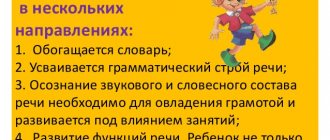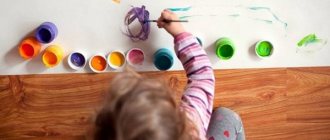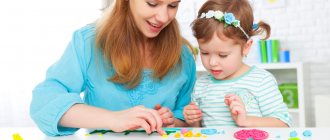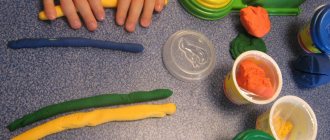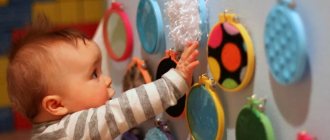Article “Sensory development of young children”
“Play permeates a child’s entire life. This is the norm even when the baby is doing something serious. He has a passion and it must be satisfied. Moreover, his entire life should be imbued with this game. His whole life is a game” A.S. Makarenko
Experts say that a child is born with natural abilities to understand the world through the perception of objects and phenomena. However, the growing baby no longer has enough natural abilities to fully develop. Therefore, in the first years of a child’s life, parents need to make every effort to ensure that the baby can train the abilities of his senses, as well as improve them in the future.
To do this, it is very important to provide him with the full range of first impressions, thanks to which his psychophysical development will occur much faster and more efficiently. In other words, it is necessary to actively use techniques aimed at the child’s sensory development. Sensory development, aimed at the formation of a full perception of the surrounding reality, serves as the basis for knowledge of the world, the first stage of which is sensory experience. The success of mental, aesthetic and moral education largely depends on the level of sensory development of children, that is, how perfectly the child hears, sees, and touches the environment.
At the stage of early childhood, familiarization with the properties of objects plays a decisive role. Professor N.M. Shchelovanov called early age the “golden time” of sensory education. After a series of observations, it was revealed that sensory development, on the one hand, forms the foundation of the child’s overall mental development; on the other hand, it has independent meaning.
1. Theoretical foundations of sensory education for young children
Sensory development (sensory) is the process of forming certain ideas about the properties of objects: their size, shape, color, position in space, tastes, smells, etc. When a baby first encounters the diversity of shapes, colors and events around him (and this happens almost in the very first days of his life), it is important not to miss this time, to help him get used to this world and push him to self-improvement.
It is these goals that are fundamental in the sensory education of a child - a systematic, consistent introduction to the so-called sensory culture. Of course, even without the help of parents, the child, one way or another, knows the world as it is, but this knowledge, without proper sensory development, may turn out to be false or incomplete.
Unfortunately, many parents, focusing in the first years of their baby’s life on caring for him, proper nutrition and routine, beautiful and comfortable clothes, do not attach much importance to the fact that the child also needs “food” for the mind. What difference does it make, they think, when a child learns to arrange balls by color and size, make buildings from cubes, lace his shoes, hold a pencil, draw, sculpt, read, write. Why rush? The time will come - everything will be learned, in the end, they will teach it in kindergarten or at school. But the main thing in the early development of a child is not to waste time! According to research by psychologists, a child under the age of three acquires from 60 to 70% of information about the world around him, and for the rest of his life - 30-40%. The importance of sensory development in early and preschool age is difficult to overestimate. It is this age that is most favorable for improving the functioning of the senses and accumulating ideas about the world around us. In early childhood, perception remains imperfect. The child cannot consistently examine an object and identify its different sides. He picks out some of the most striking signs and, reacting to it, recognizes the object. It recognizes colored and contoured objects painted in unusual colors equally well. That is, color has not yet become an important feature for a child that characterizes an object. According to experts, sensory development, on the one hand, is the foundation for the overall mental development of the baby, and on the other hand, has a completely independent meaning as a way of developing sensations, perceptions and ideas in children. And it is precisely the early age that is most favorable for the accumulation and systematization of ideas about the world around us and the improvement of the activity of the child’s sense organs. The development of object-based activity at an early age confronts the child with the need to identify and take into account in actions precisely those sensory attributes of objects that have practical significance for performing actions. The shape and size of objects, if necessary to perform a practical action, are highlighted correctly. In other situations, perception remains vague and inaccurate.
The child’s performance of instrumental and correlative actions creates conditions for him to master perspective actions, which in turn make perception more accurate and correct. At first, the child does not know how to visually correlate objects and performs the correlation of actions based on external indicative actions. The nature of the child’s orienting actions changes when he begins to measure (compares with it) to identify the necessary ratio of objects according to the attribute. Gradually, the comparison of the properties of objects with the standard begins to proceed on the basis of vision without practical actions.
In the third year of life, some objects that are well known to the baby become permanent models with which the child compares the properties of any objects (for example: triangular objects with a roof, red objects with a tomato). The child proceeds to visually correlate the properties of objects with a standard, which is not only a specific object, but also the idea of it. Young children have difficulty learning words denoting characteristics of objects and almost never use them in independent activities. Sensory education occupies a huge place in the pedagogical process and is carried out constantly: - in educational activities (the inclusion of sensory education tasks, their connection with meaningful activities for the child allows the teacher to systematically form sensory processes, promote the mental development of children, practically acting with objects, the child accumulates sensory experience) ; - in everyday life (the child’s personality is enriched through direct communication with nature, with the phenomena of social life, with the world of things created by human hands).
Sensory development involves the formation in a child of perception processes and ideas about objects, objects and phenomena of the surrounding world. A baby is born with sensory organs ready to function. But these are only prerequisites for perceiving the surrounding reality. Full sensory development is carried out only in the process of sensory education, when children purposefully form standard ideas about color, shape, size, the signs and properties of various objects and materials, their position in space, etc., develop all types of perception, thereby laying the foundation for development of mental activity. Sensory development creates the necessary prerequisites for the formation of mental functions that are of paramount importance for the possibility of further learning. It is aimed at developing visual, auditory, tactile, kinetic, kinesthetic and other types of sensations and perceptions.
2. Sensory tasks
The priority tasks for the sensory development of children of early preschool age are:
- Enrich children's direct sensory experience in various activities. Examine objects, highlighting their color, shape, size;
- Encourage to include hand movements on the object in the process of getting to know it: circling parts of the object with your hands, stroking them, etc.;
- Find and establish similarities and differences between objects that have the same name (same shoulder blades; big red ball - small blue ball);
- Practice naming the properties of objects;
- Quantity. Form groups of homogeneous objects. Distinguish between the number of objects: many - one (one - many);
- Magnitude. Draw children's attention to objects of contrasting sizes and their designation in speech (large matryoshka - small matryoshka, etc.);
- Form. Distinguish objects by shape and name them (cube, brick, ball);
- Orientation in space. To accumulate in children experience in the practical development of the surrounding space (group premises, apartment, house, etc.);
- Expand the experience of orientation in parts of your own body (head, face, arms, legs, back);
- Follow the adult in a certain direction.
It is important to understand that the sensory education of a child must take into account his age characteristics. With normal development, children under six months, as a rule, observe the movement of objects, make grasping movements, and show interest in bright toys and loud sounds. Over time, the baby begins to become interested in smells and tastes.
From one to three years, a child acquires basic knowledge about the signs of things around him. It is at this age that he develops concepts of shapes, colors, sizes, tastes and smells. In the fourth year of life, the main ideas about the characteristics of objects are mastered, as well as sensory standards are consolidated. This is the beginning of an analytical perception of objects and events surrounding the child.
3. Sensory standards
Sensory standards for children at an early stage of development are considered to be:
- nine primary colors of the spectrum;
- five geometric shapes (square, triangle, rectangle, circle, oval);
- three sizes (sizes) of an object: large, medium, small;
- musical notes, sounds of the native language;
- four tastes (sweet, bitter, salty, sour);
- two temperature definitions (warm, cold);
- five types of smell (sweet, bitter, fresh, light, heavy).
Depending on the age of the baby, the requirements of sensory education require the following knowledge and skills.
For ages 1.5-2 years:
- understanding and ability to name 3-4 colors, as well as correctly select them according to the sample;
- orientation in the sizes (magnitudes) of objects, the ability to disassemble and assemble a three-dimensional matryoshka doll;
- the ability to correctly assemble a colored pyramid of 4-6 rings of different sizes;
- the ability to correctly correlate the configuration of three-dimensional figures with flat ones;
- have basic drawing skills (draw horizontal, vertical, short and long lines, and also clearly explain what he drew).
For ages 2-4 years:
- understanding and ability to name 6 colors, as well as correctly select them according to the sample;
- orientation in 3-5 contrasting values (sizes);
- the ability to assemble a colored pyramid of 6-8 rings of different sizes;
- the ability to correctly form a whole object from 4 parts (cut pattern, folding cubes);
the ability to clearly distinguish between three-dimensional objects by shape (cube, ball, pyramid, etc.) and flat objects by outline (square, triangle, rhombus, circle).
4. Forms and methods of work on sensory development.
Sensory development of children is carried out through different forms and methods of work:
-experimentation games: Children love to experiment. The most optimal option for children's experiments in kindergarten and at home are materials such as sand and water. Playing with water is one of children's favorite activities; familiarization with the properties of water takes place during specially organized games - activities under the supervision of a teacher. Water excites the child, therefore, first it is necessary to teach him how to handle it correctly and carefully: do not splash over the edge, do not make sudden movements. At first, children simply put their hands in the water and move their fingers. Then young children are taught to catch toys with a net, launch ships, boats, colorful balls, pour water from bucket to bucket, pour it into a strainer and watch how the water flows through the holes. You need to pay attention to the fact that the water can shimmer, gurgle, bubble, be light, transparent, or cloudy. When launching boats with children, watch how it floats and, after a certain time, sinks. Why? The paper is wet. This is how the game “Drowning or Not Drowning” appeared in the process. When children lose interest in boats, omit other objects. Also, during the game, you can teach children not only to carefully pour water, but also to maintain interest, color the water in different colors. Encourage children to pour water into mugs for dolls themselves. To fix the color, play “Multi-colored water” - add a few drops of paint to the jar and watch how the water turns colors. During the game you need to constantly maintain interest. The second material that allows you to better understand the world around you and study the properties of a universal building material yourself is sand. Playing with sand brings great pleasure to any child. Sand therapy calms excitable children, helps relieve stress in passive children, relieves anxiety, and fills them with joy. In games, offer to pour water on the sand; when it is damp, it is good to play with. While watering the sand, ask questions: “Why is the water not visible in the sand?”, “Where did it go?”, “What can be made from wet sand?” Please note that the sand can be dry or wet. Dry sand crumbles - nothing can be built from it, but it can be poured in a thin stream and sifted through a sieve. You can draw on the sand with a stick, leave marks, you can build towers and roads from wet sand. Beat them. Playing with sand is very relevant now and in working with young children, as tactile-kinesthetic sensitivity and fine motor skills of the hands develop, as well as the development of mental operations.
-N Observations and outdoor games: During observations in nature, children receive many impressions. When introducing children to a variety of trees, it is necessary to draw their attention to the fact that some trunks are smooth (birch), while others (spruce) are always rough. In order to understand the meaning of these words, children just need to touch the trunk with their hand. Of great importance when working with children, they have outdoor games. For example, when studying the concepts of “tall”, “low”, children determined during observations (a tree is high and low, after explaining the rules of the game, then she said: “One, two, three, run to the tall birch tree!” ", or "One, two, three, run to the low birch tree!" - children really like this game, it develops their thinking, sensory abilities, gives them the opportunity to practice running and creates a positive emotional mood. In order to interest the kids, sometimes you need to take toys for a walk: a doll, a bear, etc. Then you can use the following game exercises: “Show the bear a red, (yellow, green) leaf,” “Bring the bear one large and one small leaf,” “Let’s show the doll Katya , where wide (narrow) leaves grow”, “Choose a red (yellow) flower for Katya.” A variety of vegetables were planted in the kindergarten garden in the spring. The teacher and the children planted large seeds: beans, peas, and onions. It is necessary to draw children's attention to the color of the earth, offer to touch it with their hands - if it is dry, then the seedlings need to be watered. At the same time, inspection skills are not only reinforced, but also a caring attitude towards plants is cultivated.
—Didactic games:
In life, a child encounters a variety of shapes, colors and other properties of objects, in particular toys and household items. And of course, every child, even without targeted education, perceives all this in one way or another. But if assimilation occurs spontaneously, without the reasonable pedagogical guidance of adults, it often turns out to be superficial and incomplete. This is where sensory development comes to the rescue - consistent, systematic familiarization of the child with sensory culture. Didactic games are the most suitable form of sensory learning for children. Before you start the game, you need to arouse children's interest in it and the desire to play. This can be achieved in various ways, using nursery rhymes and educational toys. To properly form children’s ideas about color, work should be carried out in stages:
-at the first stage, children are oriented in two contrasting colors, and the ability to select homogeneous paired objects to match a sample is developed. To do this, the following didactic games are played with children: “Show the same mosaic”; “Bring the same ball”; “Place it on plates” (at the same time, I used new objects each time: markers, cubes, caps, so that the children would be interested and the proposed game would not get boring); “Find a pair” (mittens, boots). - at the second stage, children are oriented in four contrasting colors: red, blue, yellow and green. This is facilitated by the selection of various objects (strips, cubes) according to the pattern. At this stage, children like such didactic games as “Tie strings to the balls”; “Place a bouquet of flowers in a vase”; “Hide the mouse”; "Sort by color"; “Light the flashlight.”
- at the third stage - selection of toys, natural materials to the word indicating the color of the object (4-6 colors). Children play and complete the following tasks: “Find objects that are only yellow (red, blue, etc.) in color” (cube, ball, plate, flag); "The Hen and the Chicks."
By the end of the school year, many children correctly name the primary colors. For those children who find it difficult to name colors, it is enough that the kids can show objects of the color that they name. To form ideas about the shape of objects, it is necessary to carry out such practical actions as superimposing figures, applying, turning over, tracing the outline with your fingers, and feeling. After mastering practical actions, it is easier for the child to recognize the figures that need to be known at an early age. To correctly determine the value, children form the following ideas: - selection of identical values according to the sample; -differences between objects in size by applying and superimposing; - assigning names to objects of different sizes “large”, “small”, “short”, “long”, “narrow”, “wide”. In games to determine size, use toys of different sizes: soft cubes, balls, boxes. Games: “Which ball is bigger”, “Big and small dolls”, “Fruit picking”, “Pyramids”, “Find a cube (big or small)” contribute to the development of mental processes such as attention and thinking. Children develop skills about the size of objects.
—Working with parents:
To develop tactile sensations, use games such as “Handkerchief for a doll”, “Recognize the figure”, “Wonderful bag”.
The most important condition for ensuring the holistic development of a child’s personality is the development of constructive interaction with the family. The leading goal is to create the necessary conditions for the formation of responsible relationships with the families of pupils and the development of parental competence (the ability to resolve different types of socio-pedagogical situations related to raising a child); ensuring the right of parents to respect and understanding, to participate in the life of the kindergarten. Parents and educators need to overcome subordination and monologism in their relationships with each other, give up the habit of criticizing each other, and learn to see each other not as a means of solving their problems, but as full partners and employees. To cooperate with parents, the teacher needs to place consultations, memos, booklets, folders on sensory development in information corners for parents, conduct individual conversations, parent meetings, and seminars.
It is possible to develop a child correctly only when the uniform requirements of the kindergarten and the family are met. Therefore, it is very important to provide the necessary assistance to parents in the sensory development of children and to involve them in participating in joint work.
And in conclusion, the sensory development of a child, with the right approach, not only shapes his consciousness and ability to assess current events. By working with your child and introducing him to sensory culture, you open up unlimited opportunities for him to demonstrate potential talents, as well as self-realization at the stage of adulthood. In addition, early sensory skills are the basis for strengthening the child’s social behavior skills, the roots of which are in communication with parents
The world around a child is diverse, all phenomena in it are connected into a complex system, the elements of which are changeable and dependent on each other. Therefore, it is very important to teach a child to find unknown properties in familiar objects, and, on the contrary, to look for what has long been familiar and understandable in unfamiliar ones. And all this in a relaxed and exciting atmosphere of the game. While playing, a child gets acquainted with the world around him and learns new things more easily and willingly. And, what is especially important, by playing, he learns to learn. It is very important to encourage and cultivate the habit of learning, which will certainly become the key to his future success.
It is important to note that the impression gained from observing the actions of adults will be better cemented in the child’s memory if he reproduces these actions in his own play. Therefore, it is necessary to use aids and toys, by using which the child practically becomes familiar with the properties of objects - size, shape, heaviness, color and, by acting, reproduces impressions received from the environment. However, no matter how diverse the benefits presented to the child, they themselves do not ensure his sensory development, but are only necessary conditions that contribute to this development. An adult organizes and directs the child’s sensory activity. Without special educational techniques, sensory development will not be successful; it will be superficial, incomplete, and often even incorrect. Already in very early childhood, toys shown by adults evoke a longer, and therefore better, perception than a toy simply hanging in front of a child’s eyes.
It is necessary to promote the development of sensory abilities and better perception through various techniques during games, special activities and observation of the environment. Without sufficient development of perception, it is impossible to know the qualities of objects; without the ability to observe, a child will not learn about many phenomena in the environment.
In early childhood, the greatest importance is not the amount of knowledge that a child acquires at a given age, but the level of development of sensory and mental abilities and the level of development of such mental processes as attention, memory, and thinking. Therefore, it is more important not so much to give children as much different knowledge as possible, but to develop their orientation-cognitive activity and ability to perceive.
The development of object-based activity at an early age confronts the child with the need to identify and take into account in actions precisely those sensory attributes of objects that have practical significance for performing actions. The child’s successful performance of practical actions depends on the preliminary perception and analysis of what needs to be done. Therefore, the sensory processes of each child should be improved, taking into account the content of his activity.
Important periods of development
The sensory development of preschool children is divided into stages based on the number of years they have lived. The degree of learning of a child depends on the success of passing each stage. When acquiring school knowledge, a child is helped by the ability to draw conclusions from an early age. It develops his intellect and helps to form analytical thinking.
- The first year of life is characterized by acquiring knowledge through sensations. The baby is observing objects that have disappeared from his field of vision. It is important not to include cartoons and commercials for your child. An alternative to them is a variety of objects with different shapes and colors. It is acceptable to use moving toys. Regardless of the gender of the child, buy cars. By pushing and rolling them, the little one begins to understand the connection between his actions and understand the effect of them.
- About three years is an excellent age for learning new knowledge. This time is suitable for studying the basic shapes of objects and comparing their sizes. Tell your baby about primary colors, teach them to distinguish them and name them. A simple game is suitable for consolidating knowledge: instruct the child to find the necessary one among a pile of toys - a yellow cube, a blue ball, a green block. The main toy of this period is the construction set. You can build from it, as well as sort its elements by color and size.
- After 4 years, sensory standards are formed. The baby already associates the name of the figure with sensory ideas. The period is suitable for deepening previously acquired knowledge: highlighting shades of color, measuring the size of objects, dividing complex object forms into simple ones.
Regardless of the stage of development, it is necessary to provide the baby with a full set of necessary toys.
Sensory perception is necessary to find simple cause-and-effect relationships. This area of development should be addressed not only by parents, but also by teachers. Nowadays, preschool institutions have developed their own educational programs aimed at obtaining a variety of knowledge. Kindergarten helps to look after the baby, educate him, and prepare him for school.
Peculiarities of perception in infants
The sensory development of young children practically does not use demonstration; games are not at all suitable for this stage. The baby receives the first information from its mother; it is important to establish tactile contact with her. In addition to touch, a newborn has a sense of smell. Until three months, he should spend more time with his mother, constantly feel her nearby.
Some parents at this stage of development make a serious mistake - “they do not accustom the child to holding hands,” they forbid sleeping with adults and prefer artificial feeding to natural feeding. Teachers do not recommend adhering to radical methods of education, as this causes the baby to lack natural sensory skills.
Psychologists believe that setting boundaries for a child contributes to delayed emotional maturation. Experts agree that for normal development you need to use:
- daily stroking massage, light gymnastics;
- co-sleeping during the day or at night;
- bathing combined with gentle stroking;
- wearing on the chest using special devices or often being held in the arms;
- showing love with affectionate hugs and kisses.
Place pieces of different fabrics on the changing table: velor, velvet, silk, fleece, calico and flannel. For air baths, place the baby on these fabrics so that he gets first impressions of different surfaces. Until three months, place monochromatic objects in basic colors in front of the baby: red, yellow, green, blue. Children over 3 months old can be trained using finger games.
For independent study, such kids can be given a mirror and multi-colored toys. Look at the view from the window together, watch nature on a walk. A good help for getting through the initial sensitive stage will be a special mat, on the arcs of which there are toys and small mirrors.
Don't give away the heavy glass mirror from your mother's makeup bag. Modern educational toys marked “0+” have their own mirrors made of thin plastic. They do not give such a clear reflection, but for the baby it will be enough.
During the day, infants will benefit from listening to high-quality instrumental music. Select for him light classical and modern works, the performance of which has not undergone electronic processing. Bookstores often display collections for children under one year old on their shelves. The selected compositions have a beneficial effect on the child, and the sound of a heartbeat is recorded against the background of music, reminding the baby of the prenatal period.
The introduction of complementary foods is an important stage of development. It starts with only one-ingredient purees, not only because of the risk of allergic reactions. With the correct introduction of complementary foods, you help the child learn the taste of different foods: vegetables, fruits, meat, cereals. Spices, salt, sugar are prohibited during the first feeding.
What should a child from 1 to 3 years old know?
Early preschool age is the best time for development, since the baby has a well-developed memory. He grasps any information on the fly. The sensory development of children of primary preschool age reaches its peak from 2 to 3 years of their life. For this period, methods based on the subject area of activity are suitable. Before the age of three years of life, the baby must learn how to properly use safe objects. Up to three years of age, the child should:
- find among many objects of a given basic color;
- know the simplest forms, be able to distinguish them;
- name basic colors with ease;
- build a tower from simple cubes;
- understand differences in sizes;
- sort toys by color;
- choose an item based on its description (by color, shape, size);
- be able to describe an object by texture (smooth, rough, soft);
- build models from the constructor according to the proposed model.
Play is one of the most effective learning methods for this age. It is important for parents to teach their child to approach toys creatively - use them in role-playing games, perform different tasks. It is important to give them samples, imitating which the baby will decorate dolls or build models.
It is worth adding intangible images to your classes - reading children's literature, listening to music and audio fairy tales. Memorize short nursery rhymes, nursery rhymes, and songs with your little one. Say phrases from books together. These classes will further develop the baby’s speech and replenish his vocabulary.
If a child cannot complete some of the tasks from the list above by the age of three, there is no need to be upset. It is enough to do them most of the time for several weeks to “pull up” your knowledge. Often it is enough to present the information correctly to the baby so that he remembers the colors or shapes. For some children, learning comes easily if we use blocks or construction sets as an example, while others remember colors with the help of pencils or paints.
Some knowledge can be obtained very easily, in which case it is worth deepening it. If the baby easily distinguishes large from small, then medium-sized objects can be added to the comparison. The demonstration technique is most suitable for this age. Use for it: drawings, cubes, dolls, rubber animals.
Development at this age can be complicated by the baby's reluctance to talk or problems with the pronunciation of certain sounds. If you feel that the child cannot now pronounce the desired name, pronounce it more often to remember it. Activities during which colors and shapes are mentioned more than once are imprinted in the child’s memory. Later he will demonstrate his knowledge.

